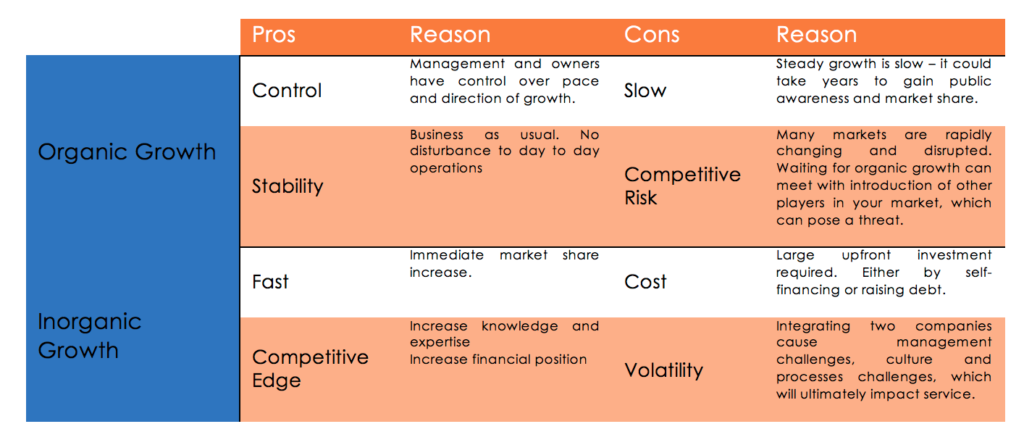There are a handful of tactics companies can employ to increase their share of market. Expanding market share requires us to first understand what market share is before we get into tactics.
Market share represents the percentage of an industry or market’s total sales that is earned by a particular company over a specified time period.
Market share is calculated by taking the company’s sales over a period and dividing it by the total sales of the industry over the same period. This sounds straight-forward, doesn’t it?
The trick is to define our market before we can claim ownership of a share in it. Defining a market isn’t that straight-forward though. We need to understand our existing customers as well as our potential customers, what options they have, what they are looking for, their purchase behaviour and other factors. This holds true whether you’re selling physical products or professional services.
Let’s examine a simple example. Let’s say you own a small watch shop. The watch industry is very broad and very heterogeneous, in which prices range from $7 for children’s watches to hundreds of thousands of dollars for custom-made luxury timepieces. So assuming your market is simply ‘Watches and Time Pieces’ is not realistic. Furthermore, since you own a shop, you could also consider yourself as part of the Retail industry. Would it be fair to you to count yourself as part of the global retail industry, which turns over hundreds of billions of dollars per annum? Obviously not! We would also need to consider whether you have only a main-street shop, or do you also run an e-commerce (online) business.
To define our actual market, we need to drill down and use some basic yardsticks – goods / services sold, geography and distribution mechanism or channels.
With Professional Services, it works exactly the same. If you’re a Doctor, an Accountant, a Lawyer, a Broker or a Consultant, the market definition factors are still valid.
Now that we have the market definition under control, what can we do to grow our market share? If our strategic goal is to increase market share, what are our options? Ultimately, we only have two ways:
- Organic market growth
- Inorganic market growth
Organic growth is the process of business expansion by increased output, customer base expansion, or new product development, as opposed to inorganic growth which is growth by mergers and acquisitions.
Organic Growth
An organic growth happens when businesses focus on YoY (year on year) growth by increasing production, servicing more clients or selling additional services. Looking at historical data and applying a total percentage of sales growth – e.g.: “increase sales by 10% year on year” – is a common goal, which ensures a company’s sustainability, but doesn’t necessarily guarantee increased market share.
For example, if you’re running an accounting firm collecting $750,000 of fees in 2016, you’d aim for $825,000 fees in 2017 financial year, $907,500 for 2018, and so forth. That demonstrates growth, but not necessarily market share growth. It is possible that the market increased by 10% per year, meaning you are just keeping up with market growth but not increasing your share of the market.
Another common approach to organic growth is adding more services or products to our practice. Using the above example of the accounting firm, we can introduce technology sales (MYOB, Xero, or QuickBooks partnerships), financial planning, mortgage broking, insurance sales, etc. A lawyer can increase market share by venturing into other territories and servicing a larger geographic area.
This approach has been proved to be a successful way of growing your share of the pie. But are you really increasing market share, or growing the market segments or geographies you’re competing in? Like in the watch shop in the previous example, if we’re adding engagement rings, are we growing market share, or just adding market segments?
To help us find organic ways to grow not only our market but market share, let’s focus on understanding our customers and their purchase preferences. We also need to keep tabs on our competition and understand what they do, and the variety of services they offer.
To grow our market share within a defined marketplace, we need to “steal” customers from our competition. There is no other way to grow our market share. How do we do that?
- Grow brand awareness – Making sure more people know about us, so they can buy from us. If our target market doesn’t know about us, they can’t do business with us. This will involve every kind of promotional activity you can think of, and afford: online and offline advertising, direct mail, radio and TV, billboards, etc.
- Direct Sales activities – Find out where and how your direct competition does business and encourage their customers to buy from you. Offering sales incentives, better service, more convenience, cheaper prices, and anything else that may entice your competitor’s client to buy from you.
Those activities have been working well for many businesses to grow their market share. However, it takes time and resources many businesses don’t have.
Inorganic Growth
Inorganic growth refers to activities that are shorter in time frame and bypass the need to entice customers away from your competition. Companies looking to expand their control of the market in a specific segment can acquire, merge with, or take over other players in the market.
The most common examples of mergers and acquisitions (M&A) activities in professional services can be found in the accounting and legal professions. The ‘Big 4’ accounting firms employed inorganic growth tactics to get where they are today. Similarly, the top legal firms in the world used similar strategies. The Partnership business model allows rapid expansion by acquiring smaller firms, making the owner of the acquired firm a partner in the larger firm, and bringing their client base with them.
As a side note – In the technology world, a practice called “acqui-hire” is commonly employed, where large companies (Google, Apple, Microsoft, etc.) will buy smaller start-ups or other companies, not for their client base, but for their talent (the people and expertise that are within those companies).
The Big 4 accounting firms[1] also expand their market share by taking a more customer-centric approach. They are shifting from their traditional accounting and audit service lines and specialisations to become business advisory and consulting firms, and are now expanding their services to encompass project implementation too. In truth, the Big 4 accounting firms haven’t been primarily “accounting firms” for several decades. Instead, these large, sophisticated and increasingly global firms have been slowly but surely transforming themselves from audit firms, to multidisciplinary professional service firms, to “globally integrated business solution providers”. Those firms are not only expanding their own market share, but threatening to eat other industries’ cakes too – competing head to head with management consultants, ad/media agencies, legal firms, and IT service providers. Their growth strategy revolves around their customer, and they are aiming to provide every service imaginable to their customer, to help them grow.
On a personal note, I’ve had multiple conversations with partners in some of those Big 4 firms, looking to integrate marketing services under their client offering. It’s an integral part of their growth strategy, and they are willing to pay to buy companies for both their clients and talent.
As a small or a medium size business owner, you may want to begin exploring the growth opportunities available to you, within your market segments. But how do you do that?
- Define your own strategic growth ambitions: How large do you want to be, and what is the time frame in which you want to achieve that goal?
- Articulate the market segment or geography you’d like to expand.
- Identify potential acquisition targets. You can ask your accountant for advice, or ask to be referred to a business broker, advisory firm or M&A specialist to help you with identifying other companies with a similar mindset.
Don’t be overly concerned about financing that acquisition or merger. Banks and financial institutions will be thrilled to help you, if the deal is properly structured.
Considerations for Organic Vs. Inorganic Market Share Growth
There are pros and cons for both growth strategies. It’s not about making a right or wrong decision; it’s a decision about what’s right or wrong for you and your business, at this point in time.
David Annis and Gary Schine, authors of the book, “Strategic Acquisition: A Smarter Way to Grow a Company,” summarise their perspective:
“Growth through acquisition is a quicker, cheaper, and far less risky proposition than the tried and true methods of expanded marketing and sales efforts. Further, acquisition offers a myriad of other advantages such as easier financing and instant economies of scale. The competitive advantages are also formidable, ranging from catching one’s competition off guard, to instant market penetration even in areas where you may currently be weak, to the elimination of a competitor(s) through its acquisition.”
Growing market share by acquisition offers two-fold growth:
Growing your market, brand reach, audience, sphere of influence, and supply chain while also eliminating or overtaking your competitors by acquiring them, until your company is the largest in your competitive market.
However, there are also risks in this growth strategy, and positive attributes to organic growth activities. Let’s sum it up:
Conclusion
The question of whether to grow organically or inorganically must be answered by you as the business owner on a case-by-case basis, taking into consideration your unique circumstances.
In both cases, though, strategic planning is required to ensure growth is both attainable and sustainable over a long enough period to achieve the company’s goals and justify the expense and effort required.
It’s usually best to explore both options thoroughly before heading too far down either path. Discuss your options with your accountant, lawyer, business broker, and other trusted advisors to make sure you’re considering all the pertinent details.
[1] Big 4 refers to PwC (Price, Waterhouse, Coopers), EY (Ernst & Young), KPMG (Klynveld Peat Marwick Goerdeler) and Deloitte (Deloitte Touche Tohmatsu).
[ssm_form id=’3277′]


